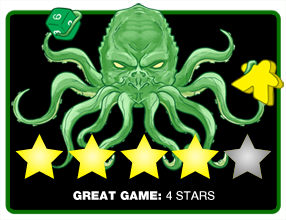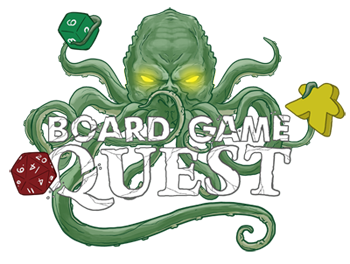 Embarrassingly, I haven’t played any of the previous versions of Horrified and had passed on them, figuring the themes weren’t a fit for my family. But it was a game I’ve recommended to friends who enjoy the Horrified themes and enjoy lighter cooperative games.
Embarrassingly, I haven’t played any of the previous versions of Horrified and had passed on them, figuring the themes weren’t a fit for my family. But it was a game I’ve recommended to friends who enjoy the Horrified themes and enjoy lighter cooperative games.
Enter the Dungeons and Dragons version and suddenly I was enthralled, as if under a spell. Dungeons and Dragons will always have a special place in my gaming heart as it was my first interest in gaming. The adventure and exploration aspect of RPG’s is what rekindled my interest in board gaming as an adult and have also recently introduced my son to old school D&D and 5e.
How does the D&D theme integrate with the Horrified mechanics, and is this the right Horrified for your gaming collection?
Gameplay Overview:
Like the other Horrified games, you’ll start by picking two monsters to battle against. The choices are Beholder, Displacer Beast, Mimic, and Dragon, and each has their own unique setup instructions and is a unique challenge to defeat.
Each player will also pick a character and place their standee in their starting location.
Players will have four actions to take on their turn, which they can do the following:
- Move one space also moving citizens with you
- Guide one citizen from your location to an adjacent one or from an adjacent space to your space
- Pick up any number of item tokens in your location
- Share or exchange items with heroes in your location
- Advance uses items to make progress on a monster’s challenge
- Defeat uses one or more items to defeat a Monster
- Reveal a Lair, which allows you to flip over a token to see if a monster is hiding in that location.
- Special Action is a unique ability each character has, where you roll a twenty-sided die (often called a d20 roll) and get to do something cool, including being able to manipulate the monsters on their turn

The mimic spends most of the game wandering around its own player mat, occasionally consuming items (rude!) while landing on teeth spaces. On those spaces, draw an item, and if each player has an item of that color, discard it and place the mimic on the board where it can be defeated by discarding blue items worth 6+ points. To defeat the Displacer Beast, players discard items to cover hit locations on the monster’s mat. Then, when trying to attack it, which requires discarding 7+ items per attack, the d20 is rolled and if a covered number is rolled, the displacer beast is defeated.
The Beholder attacks with its various eye stalks randomly (using the d20), and players discard items and roll a d20 to damage zero to three eye stalks. Once all 10 eye stalks have been marked off, 6+ yellow items can be discarded to defeat the beholder.
The dragon is the most complicated and the only one that uses the lair mechanic. You need to find the Orb of Dragonkind, solve a slide puzzle, and find the dragon’s lair. Then lure the dragon in by picking up items from the lair, placing items on the lair, and then rolling a d20, where the sum of the items and the die needed to exceed 20 to vanquish the Red Dragon.
After each hero goes, you draw a card for the monsters, which adds items to the board, generates events, and moves the monsters around where they attack players or citizens and do other actions that raise the terror rating in the city. When it reaches seven, represented by a skull, everyone loses.

Game Experience:
I love mix-and-match type games (as noted by my love of Marvel United and Cthulhu Death May Die), and that’s a strength of Horrified. The rulebook points to a website with instructions on how to use monsters from other games, but the link wasn’t working. I could easily imagine expansions or a second standalone box with additional iconic D&D monsters like the owlbear, carrion crawler, rust monster, and driders, just to rattle off a few more.
For fans of D&D and especially the Forgotten Realms setting, there are a lot of name drops to famous people and locations. The map also features several fast travel options, including some teleportation circles or portals/staircases between areas, such as the Yawning Portal leading into the dungeon level.

The art on the mat reminds me a bit of Pandemic Reign of Cthulhu, with nighttime colors and a slightly haunting/foreboding appearance. The art on the cards is vibrant and fantastical, with some potentially mildly scary imagery but nothing graphic or gory. The item art is good, but the items are fairly generic, and thematically, I found that I was just referring to them by their color and value instead of “I’ll use my battle axe and lantern!” The monster minis are cool. They’re soft plastic, so don’t expect the quality of one of your average Kickstarter or even the D&D Adventure Series games, but they’d probably still look cool with a coat of paint.
Another place where the theme was a little lacking was the characters and civilians. They’re all pretty generic. And while the heroes do have that special ability action, it’s not a huge difference. I wasn’t worried about my squishy wizard getting crushed or if my rogue could use the maul I found, as that part of the theme was kind of pasted on.
On the positive side, every game I’ve played has been down to the wire between the monster deck running out or the terror level rising too much, with the dragon quest being the single hardest to win (like a halfling playing basketball; I came up short). Some of the slide puzzles were more challenging than I anticipated, and with each movement requiring an item, you’ll need to gobble up items like a greedy goblin to get through, especially if/when you make mistakes.

I loved gaining perk cards, granted for saving civilians or rolling 20 or higher, and they will be critical to your success as gaining an extra two actions, taking an item from the haversack, or being able move another hero or monster can really make a difference.
The random hero action was a fun mechanic, as it gives you something to do with that fourth action when there may not be anything else to do. Each hero does different things, giving them each a slightly different vibe, so the rogue is about collecting extra items while the warrior can move to monster spaces, prevent taking damage, or prevent a monster card from being drawn, and the wizard can move heroes and monsters around the board.
As noted earlier, each of the four different monsters has its own mechanics, and the mixing and matching adds both variability and replay value. I kind of wish there was a fifth monster, especially something on the easier side for newer players, or to pair with the pain in the armor class dragon.
Similar to the previous iterations, the damage dice either do damage, forcing you to discard items, or activate the enemies’ pow! ability (these are also pretty bad), but this version, fittingly, adds more randomness with the d20 rolls and that fits the D&D theme, whose central mechanic is based around rolling high on a twenty-sided die.

Final Thoughts:
If you like cooperative board games and the D&D theme, Horrified could be a fun and shorter alternative/introduction to the role playing game. What it won’t simulate is the character progression and narrative story of an RPG. Especially for people who like cooperative games but not horror, this version of Horrified is very light on anything resembling horror.
If you have other Horrified games, this could be an option unless the monsters (*assuming they’re compatible) or theme appeals to you. Overall, I found Horrified D&D to be a fun and engaging cooperative game.
Final Score: 4 Stars – Horrified Dungeons & Dragons works well as an introduction to the world of D&D and cooperative board games.
 Hits:
Hits:
• Challenging cooperative game with light D&D veneer
• Character special actions give you something to do with each character, having varied outcomes
• Each monster is thematic to their D&D origin and a unique challenge
Misses:
• Theme is a minor illusion at times
• Only four monsters in the box
• D20 adds randomness for good and bad





















